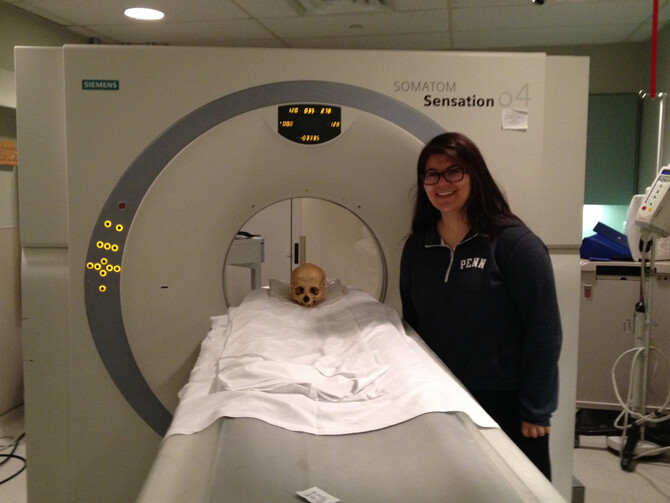Penn’s Jordi Rivera Prince Uses Bones to Tell a Story of Human Evolution
It wasn’t until she was 18 years old that Jordi Rivera Prince, a rising junior at the University of Pennsylvania, learned in depth about evolution.
The subject had been glossed over in Rivera Prince’s high school classes, where she says state-mandated lessons about Charles Darwin’s theories were “prefaced with, ‘You don’t have to believe this.’” But then a course she took at a local college immersed her in the subject and immediately drew her interest.
“It was hands down my favorite class,” says Rivera Prince, who is from Holland, Mich. “It was an entirely new field of study for me and I found it so exciting.”
Now, lessons in evolution are part and parcel of Rivera Prince’s day-to-day life as an assistant to the curator of physical anthropology at the Penn Museum of Archaeology and Anthropology. Not only does her position entail handling human fossils and educating visitors about what the specimens reveal about how our species has evolved, but it has also allowed Rivera Prince to conduct her own research on a special collection of human skulls that may soon be lost to the museum forever.
“For me, bones tell a really cool story,” she says.
After learning about the Penn Museum, Rivera Prince says she was determined to attend the University.
Upon arriving on campus as a freshman, Rivera Prince filled her schedule with anthropology courses and set a goal of getting a job at the museum by the time she graduated. It took only two months.
“The TA for my cultural anthropology course connected me with another student who was a sub-matriculant in physical anthropology,” she says. “He gave me a tour of the museum. At the end, he said, ‘Do you want a job?’”
Rivera Prince began working for Janet Monge, keeper of physical anthropology at the Penn Museum. Initially she completed basic tasks, such as taking out and putting back artifacts, filing and photocopying, then she gradually began to take on more responsibility and initiative.
“Now I’m basically like a mini-Janet,” Rivera Prince says. “One day I might be compiling a bibliography on a fossil, the next day I’ll be giving a tour to third graders about human evolution.”
After mastering the intricacies of human osteology, the study of bones, through a detail-packed class her freshman year, she was able to begin to pursue her own research. Together with Monge, Rivera Prince decided to study the museum’s collection of Native American skulls.
Because of the provisions of the Native American Graves Protection and Repatriation Act, which was enacted in 1990, museums across the country are required to return human remains to the tribes from which they were taken. The Penn Museum has already given back more than 200 artifacts and continues to conduct research to identify the biological and cultural origins of the remainder of the collection.
Though the actual bones must be returned, Penn Museum workers are amassing as much data about the specimens as possible so that research can continue after they’re gone. In addition to standard measurements and dental information, Monge and colleagues have been taking CT scans of all of the museum’s bones, a collection representing approximately 10,000 individuals.
The scans capture many intricate details about the skull’s form and can even reveal details of the internal structure of the bone that wouldn’t otherwise be known. But the CTs aren’t perfect replicas.
“You always have to be aware that, unless you’re looking at the actual bones, you’re going to lose information,” Rivera Prince says.
Rivera Prince’s project aims to pinpoint just how much CT scans miss. With support from Penn’s Center for Undergraduate Research and Fellowships, she is spending the summer evaluating the skulls epigenetic traits, which are features that can’t be measured metrically.
“They are features that can be either absent or present; small, medium or large; ridged or non-ridged,” Rivera Prince says. “Epigenetic traits can reveal quirks about the person that you might miss from the metric characteristics.”
Certain muscle markers on a skull, for example, can confirm whether the person held their head with a tilt to the right or left. And while certain people have a notch on the infraorbital bone, above the eye socket, others have an opening called a foramen.
Though some of these traits are unique to an individual, many are heritable and can be used to group populations. Her work will test whether these traits can be evaluated from the CT scans alone. In total she will be collecting 106 datapoints on each of 40 skulls, evaluating both the CT scans and the physical specimens.
Her findings could not only alter the way that the department and other forensic anthropologists collect data, but could also help ensure that researchers are correctly evaluating tribal identity when repatriating remains.
Eventually, Rivera Prince would like to use her specialized knowledge of bones to go into forensics, either as a medical examiner or as a physical anthropologist.
“I’m really passionate about forensic anthropology,” she says. “Someone’s bones are telling their story. I get to be an advocate for someone who has no voice.”








